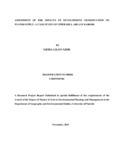| dc.description.abstract | This study was carried out in Upper Hill area, an extension of Nairobi city’s CBD, located to the south of the CBD. The aim of the study was to establish the impacts that higher density development has had on water supply in the study area. The study’s objectives were to review the changes in development type in Upper Hill between 1990 to-date; examine the effect of increased development density on water supply reliability and make recommendations on the possible approaches to development densification, with a view to sustainable water supply in growing suburbs. The study used both qualitative and quantitative data, which was analysed and presented in form of frequency tables, pie charts and graphs. The study hypotheses were tested using chi-square. Primary data was collected through administering questionnaires to residential and commercial properties in the study area, conducting key stakeholder interviews and observation, while secondary data was collated from various existing materials. According to the study findings, there has been a change in type of development in Upper Hill area, from the initial low density bungalows to higher density multi-storeyed mainly commercial, and a few residential buildings, and that this change has affected water supply in the area, necessitating use of other sources of water, other than NCWSC, including boreholes and water bowsers, and that available water supply from NCWSC is inadequate. The study concludes that the higher density development in Upper Hill has not been matched by enhanced supply of water. The study recommends that NCC comes up with an integrated plan to guide the development of the area, coupled with commensurate upgrade of the service infrastructure, and facilitates an inter-organizational effort involving all the service providers and stakeholders, to come up with guidelines on service provision in all parts of the city experiencing similar growth; NCWSC should increase the volume of water available for the area while an assessment of the existing pipe network and whether there is need for its expansion is also recommended. Other water sources such as rain and storm water harvesting should be exploited. | en_US |



